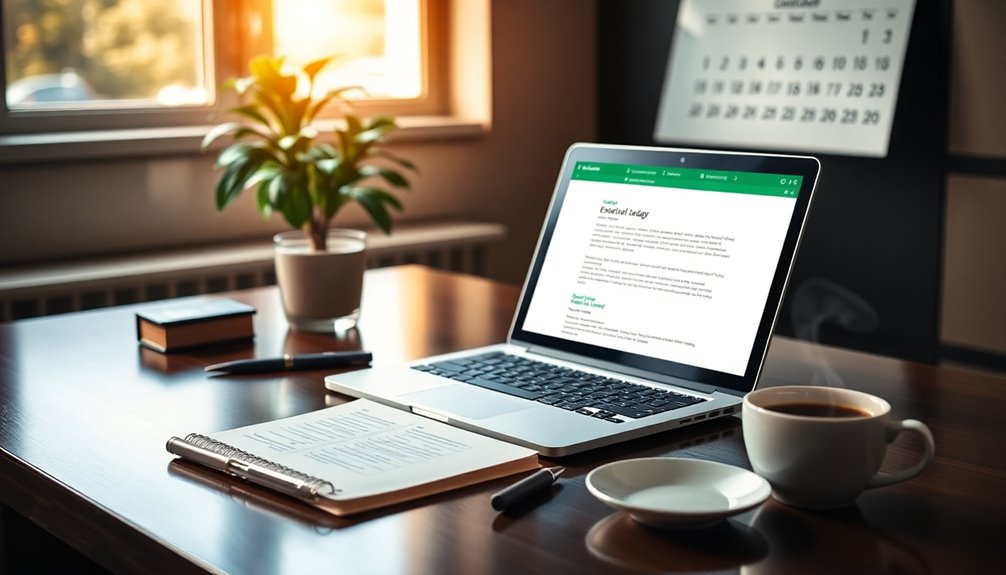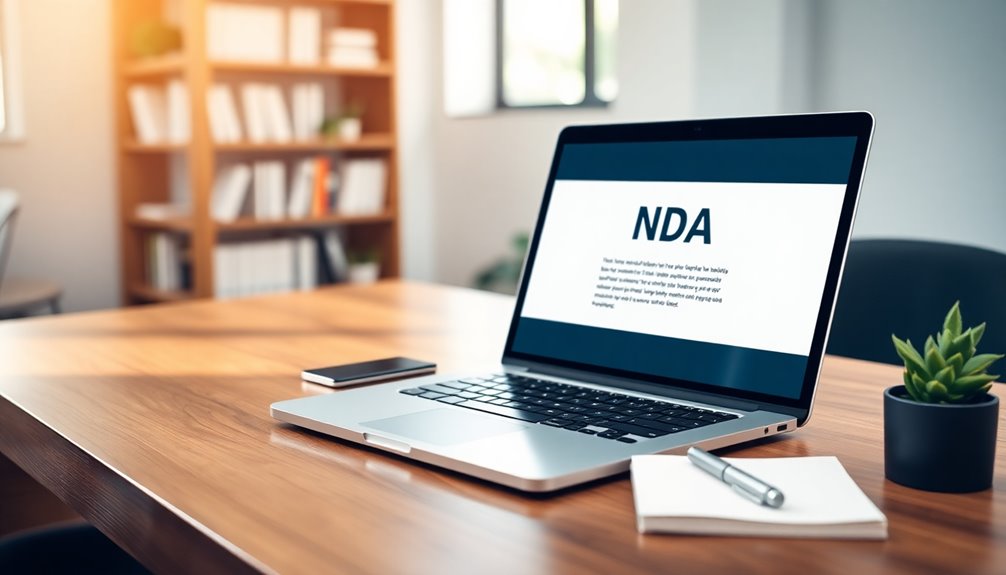To impress clients with your business emails, start with a compelling subject line that grabs attention. Personalize your email by addressing recipients by name and referencing their specific needs. Keep your message concise—under 150 words—focusing on how your service solves their pain points. Use a strong opening statement and include clear calls to action to encourage responses. Avoid jargon and structure your email for easy reading. Incorporating testimonials can build trust and credibility. If you want to elevate your email game even further, there's plenty more to explore on crafting effective communications.
Key Takeaways
- Use a clear and compelling subject line to capture attention and encourage opens, as it significantly impacts engagement rates.
- Personalize emails by addressing clients by name and referencing their specific needs or previous interactions to increase engagement.
- Keep emails concise and to the point, ideally under 150 words, to respect the recipient's time and maintain their interest.
- Clearly state your value proposition at the beginning to address client pain points and establish professionalism from the outset.
- Include a strong call to action that specifies your request, making it easy for clients to respond positively and promptly.
Introduction

In today's fast-paced business world, crafting effective emails is essential for maintaining strong professional relationships. Your business emails often serve as the first impression for potential clients, so it's crucial to make them count.
Start with a compelling subject line that grabs attention—studies show 64% of recipients decide to open an email based on this alone.
Personalization is key; addressing your client by name and referencing specific interests shows you value their time and needs. This not only enhances engagement but also establishes a connection that can lead to high-quality leads.
Keep your emails concise—busy professionals appreciate brevity.
Include clear calls to action (CTAs) that guide recipients on the next steps you want them to take. This clarity can significantly improve the likelihood of a prompt and positive response.
By focusing on these elements, you're not just writing emails; you're building trust and fostering stronger relationships. Remember, the way you communicate can directly impact your client's perception and engagement, setting the stage for future interactions.
Builds Client Trust Quickly

Crafting emails that resonate with clients not only establishes a connection but also builds trust quickly. One effective way to do this is by personalizing emails. Address clients by their name and reference specific details about their business. Studies show that personalized emails see a 29% higher open rate, enhancing trust and engagement.
Make sure you state your value proposition clearly at the beginning. This demonstrates respect for the client's time and encourages prompt responses. Using concise language and avoiding jargon fosters clear communication, which can boost client satisfaction by 25%. Additionally, understanding financial metrics can help you tailor your emails to reflect the client's key business interests and priorities. As automation technologies continue to evolve, incorporating advanced technology in your communication can further streamline the client engagement process. Including emotional support when discussing challenges can also resonate well with clients, fostering a deeper connection. Furthermore, leveraging Law of Attraction principles can help frame your message in a positive light, making your client feel more aligned with your offerings.
Including testimonials or case studies in your emails acts as social proof, building credibility and trust. In fact, 92% of consumers trust recommendations from individuals over brands. Ultimately, understanding market trends can help tailor your emails to resonate more with your clients' current interests and needs.
Strong Opening Statement

Capturing your recipient's attention right away is crucial for effective business emails. A strong opening statement not only sets the tone but also conveys the email's purpose and relevance immediately.
When crafting your first email, consider personalizing the opening by mentioning the recipient's name or referencing a specific detail about their business. This simple technique can increase your likelihood of a positive response by 20%. Additionally, leveraging predictive modeling can help you anticipate the recipient's interests and tailor your message accordingly.
To create an engaging opening, you might pose a compelling question or share a relevant statistic about their industry. This approach piques interest and encourages further reading. Additionally, utilizing data-driven marketing strategies can help you understand the recipient's needs more effectively. Recognizing patterns of behavior in your previous communications can also provide insights into how best to engage your recipient.
Clearly stating your value proposition or the benefit to the recipient in your opening sentence establishes a professional tone, positioning your email as worthwhile.
Additionally, incorporating elements that enhance your credibility, such as mentioning a mutual connection or a recent achievement, can significantly improve the recipient's perception of your expertise. In today's job market, understanding the importance of AI Ethicist jobs can also demonstrate your awareness of contemporary issues that may affect their business decisions.
Step-by-Step Guide to Cold Emails

Cold emails can feel daunting, but with the right approach, you can turn them into powerful tools for building connections.
Start with a personalized subject line that captures attention; remember, 64% of recipients decide to open emails based on this alone. Use this opportunity to reflect the recipient's interests.
Next, craft a warm opening that acknowledges the potential client's achievements. This establishes genuine interest and rapport right from the outset.
Then, clearly articulate your value proposition. Focus on how your services can address their specific pain points instead of simply listing features.
Keep your email concise and structured. Use short paragraphs and bullet points to improve readability, ensuring the main points are easily scannable.
This helps the recipient quickly grasp your message without feeling overwhelmed. Additionally, consider leveraging free SEO keywords to enhance your outreach strategy and attract more relevant clients.
Dos and Don'ts for Cold Emails

Successful cold emails hinge on a few key dos and don'ts that can make or break your outreach efforts.
First, do personalize your message. Research your prospects to tailor your emails; personalized emails boast a 26% higher open rate compared to generic ones.
Don't use generic subject lines—capture attention with specific and relevant ones since 64% of recipients decide whether to open emails based on them.
Next, do establish credibility. Introduce yourself and your company succinctly, highlighting relevant experience or achievements to build trust.
Don't overload your email with information; keep it concise. Aim for 50-125 words to maintain the recipient's interest and drive engagement. Additionally, do create a budget that accommodates your outreach efforts, ensuring you allocate resources effectively to maximize impact.
Examples of Follow-Up Emails

After reaching out with a cold email, following up is key to keeping the conversation alive. Within 2-3 days, send a follow-up email to maintain engagement and demonstrate genuine interest in your prospective clients' needs.
Start with a clear subject line like "Following Up on Our Last Discussion" to grab attention and increase open rates.
In your follow-up, include a brief recap of previous conversations. This helps refresh the recipient's memory and reinforces the context of your outreach. Personalizing emails by referencing specific details or pain points discussed earlier can significantly improve response rates and foster a stronger connection.
Make sure to incorporate a clear call to action. Whether you're suggesting a time for a call or asking for feedback, this encourages recipients to engage and take the next step in the conversation.
For example, you might write, "I'd love to hear your thoughts on the proposal we discussed. Can we schedule a call this week?"
Pro Tips for Writing Effective Emails

Crafting effective business emails is crucial for successful communication. To help you stand out, start by personalizing your emails. Address the recipient by name and include specific details that resonate with their needs. This simple tweak can increase engagement by up to 20%.
Next, make sure to utilize a clear and compelling subject line; about 64% of recipients decide whether to open an email based solely on it.
Keep your emails concise—ideally under 150 words—to maintain attention and improve response rates. A good email gets to the point quickly, so eliminate any fluff.
Don't forget to incorporate a clear call to action (CTA). Emails with a strong CTA can boost response rates by 371%, so outline the next steps clearly. If you're asking for a quick call or requesting information, make that evident.
Final Thoughts

Effective business email communication can make or break your professional relationships. To impress clients, start with engaging subject lines that draw attention.
Personalizing emails shows you understand their needs, and utilizing business email templates can streamline your efforts while maintaining that personal touch. Remember to exhibit strong communication skills to ensure your message is conveyed clearly. Additionally, focusing on content quality can further enhance your email's effectiveness and authority. To maintain engagement, consider incorporating regular breaks in your outreach strategy to avoid overwhelming the client with information. Moreover, ensuring that your emails are well-structured content can improve readability and user experience.
Focus on concise language to improve readability; bullet points can help highlight key information quickly. Remember, clients appreciate clarity.
Incorporating social proof, like testimonials or a compelling success story, boosts your credibility and encourages trust. Using quantifiable achievements can further illustrate your value and expertise.
Don't forget the importance of following up. Ideally, reach out within 2-3 days after your initial communication. This demonstrates your commitment to the client relationship and shows genuine interest in their needs.
A timely follow-up can significantly enhance engagement rates and move conversations forward. Additionally, consider establishing a clear budget plan for your email marketing efforts to optimize your outreach strategy.
Frequently Asked Questions
How Do You Write an Email to Attract Clients?
To attract clients with your email, start with a concise subject line that grabs attention.
Personalize your message by addressing their specific needs and pain points.
Clearly outline your value proposition, focusing on how you can solve their problems.
Structure the email for easy reading with short paragraphs and bullet points.
How to Write an Email to Convince a Customer?
To convince a customer through email, start by personalizing your message. Use their name and mention specific needs or interests to grab their attention.
Clearly state your value proposition early, focusing on how your product solves their problems.
Craft a compelling subject line and include a strong call to action, encouraging them to respond or schedule a meeting.
Lastly, add testimonials or case studies to build credibility and show proven success.
How to Write Professional Emails to Clients?
To write professional emails to clients, start with a clear subject line that captures their attention.
Personalize your greeting by using their name and addressing their specific needs.
Keep your email structured with short paragraphs and bullet points for easy reading.
End with a strong call to action, outlining the next steps you want them to take.
How to Write an Email Soliciting a Business?
When you're writing an email to solicit a business, start with a catchy subject line that grabs attention.
Personalize your message by mentioning specific details about their company.
Clearly outline how your product or service addresses their needs right from the start.
Use bullet points for key benefits to make it easy to read.









